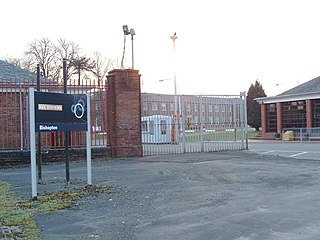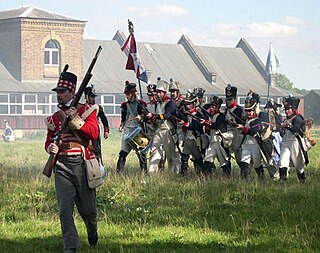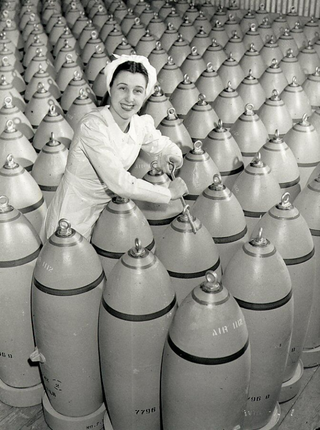Related Research Articles

Cordite is a family of smokeless propellants developed and produced in Britain since 1889 to replace black powder as a military firearm propellant. Like modern gunpowder, cordite is classified as a low explosive because of its slow burning rates and consequently low brisance. These produce a subsonic deflagration wave rather than the supersonic detonation wave produced by brisants, or high explosives. The hot gases produced by burning gunpowder or cordite generate sufficient pressure to propel a bullet or shell to its target, but not so quickly as to routinely destroy the barrel of the gun.

Royal Ordnance Factory (ROF) Bridgwater was a factory between the villages of Puriton and Woolavington in the Sedgemoor district of Somerset, England that produced high explosives for munitions. It was slightly above sea level, between the 5-and-10-metre contour lines on Ordnance Survey maps. BAE Systems closed it when decommissioning was completed in July 2008.

Bishopton (/bɪʃəptən/) is a village in Renfrewshire, Scotland. It is located around 2 miles (3 km) west of Erskine.
ROF Bridgend,, located in Bridgend, South Wales, was one of the largest of sixteen World War II, UK government-owned, Royal Ordnance Factory munitions Filling Factories. Of great significance to the Britain's war effort, at its peak of production it employed around 40,000 people — said to be the largest ever factory in Britain's history.
Royal Ordnance Factories (ROFs) was the collective name of the UK government's munitions factories during and after the Second World War. Until privatisation, in 1987, they were the responsibility of the Ministry of Supply, and later the Ministry of Defence.
A filling factory was a manufacturing plant that specialised in filling various munitions, such as bombs, shells, cartridges, pyrotechnics, and screening smokes. In the United Kingdom, during both world wars of the 20th century, the majority of the employees were women.
This article explains terms used for the British Armed Forces' ordnance (weapons) and ammunition. The terms may have slightly different meanings in the military of other countries.

The Royal Ordnance Factory was a WW2 Ministry of Supply Explosive Factory. It is sited adjacent to the village of Bishopton in Renfrewshire, Scotland. The factory was built to manufacture the propellant cordite for the British Army and the Royal Air Force. It also later produced cordite for the Royal Navy. The Ministry of Works were responsible for the site. It was the biggest munitions factory the MOD had, with up to 20,000 workers.
The Royal Ordnance Factory (ROF) Ranskill was a United Kingdom Ministry of Supply, World War II, Explosive ROF. It was built to manufacture cordite and the site was located adjacent to what is now known as the East Coast Main Line railway at Ranskill, Nottinghamshire, just north of the town of Retford.
A World War I explosive factory, which was to be later known as NEF Pembrey was built, by Nobel's Explosives, with British Government approval, near the village of Pembrey, Carmarthenshire, Wales. The factory was built on a site consisting of mainly sandhills and sand dunes to provide some protection against damage caused by an explosion. Its main product was TNT (Trinitrotoluene) used for shell filling. The same site was used in World War II to build another explosive factory ROF Pembrey, which also made TNT.


The Royal Navy Propellant Factory, Caerwent was a facility at Caerwent, Monmouthshire, Wales, UK, which was originally dedicated to the manufacture and storage of Royal Naval munitions. Since its closure as an armament works in 1966, it has been used by the US military and the British Army. It is now used as the Caerwent Training Area. A new purpose-built military barracks is set to be built on the site to house 1st The Queen's Dragoon Guards and 1st Battalion, The Rifles from 2027.

The Royal Naval Cordite Factory, Holton Heath (RNCF) was set up at Holton Heath, Dorset, England, in World War I to manufacture cordite for the Royal Navy. It was reactivated in World War II to manufacture gun propellants for the Admiralty and its output was supplemented by the Royal Navy Propellant Factory, Caerwent. After the end of World War II, the explosive manufacturing areas of the site were closed down and some areas of the site reopened as the Admiralty Materials Laboratory. A major part of the explosives site became a nature reserve in 1981. Other parts of the site were converted into an industrial estate; and some may be used for housing.

The Royal Gunpowder Mills are a former industrial site in Waltham Abbey, England. It was one of three Royal Gunpowder Mills in the United Kingdom. Waltham Abbey is the only site to have survived virtually intact.

The Canary Girls were British women who worked in munitions manufacturing trinitrotoluene (TNT) shells during the First World War (1914–1918). The nickname arose because exposure to TNT is toxic, and repeated exposure can turn the skin an orange-yellow colour reminiscent of the plumage of a canary.
Barnbow was a small settlement situated near the city of Leeds in the township and parish of Barwick in Elmet. The site is noted as the location of a munitions factory founded during the First World War. It was officially known as National Filling Factory No. 1. In 1916 a massive explosion killed 35 of the women who worked there.

The Grangeston Halt railway station was a private station that was not listed in the public timetables, located in a rural part of South Ayrshire, Scotland and served the WWII Grangeston ICI munitions plant bringing workers to the site. Grant's Distillery now occupies much of the site.
Defence Explosive Factory Maribyrnong is a heritage-listed military installation and former munitions factory at Cordite Avenue, Maribyrnong, Victoria, Australia. It was added to the Australian Commonwealth Heritage List on 22 June 2004.

Defence Industries Limited (DIL) was a subsidiary of Canadian Industries Limited (C-I-L), founded in 1939 to manufacture munitions for use in World War II. The company operated in number of locations in Canada, in the provinces of Ontario, Quebec, and Manitoba. Its Pickering Works shell-filling plant, along with nearby housing, grew into the town of Ajax.
References
- Cocroft, Wayne D., (2000). Dangerous Energy: The archaeology of gunpowder and military explosives manufacture. Swindon: English Heritage. ISBN 1-85074-718-0.
- Kohan, C.M., (1952). History of the Second World War: United Kingdom Civil Series: Works and Buildings. London: Her Majesty's Stationery Office and Longmans, Green and Co.
- Reader, W.J. (1975). Imperial Chemical Industries: A History. Volume II: The First Quarter-Century 1926-1952. London: Oxford University Press. ISBN 0-19-215944-5.